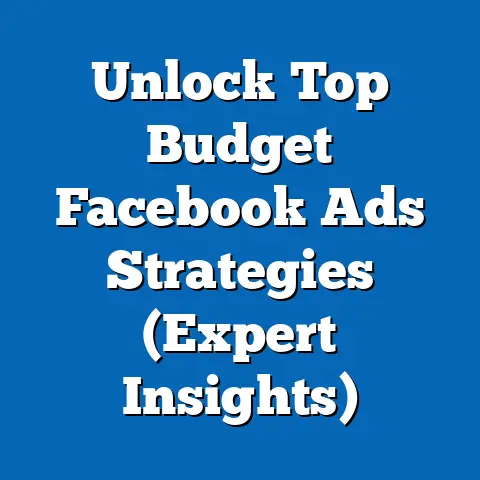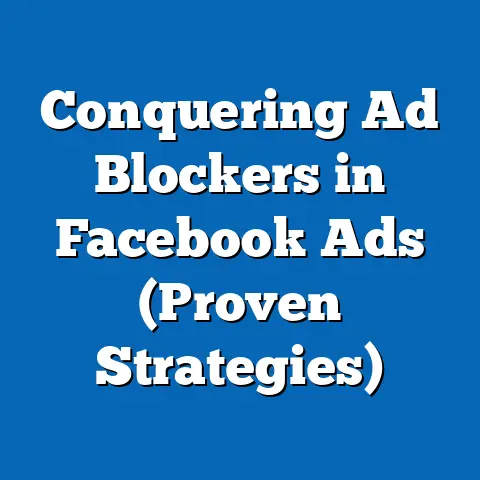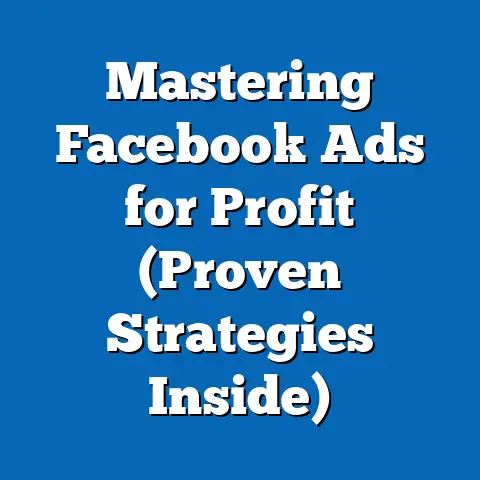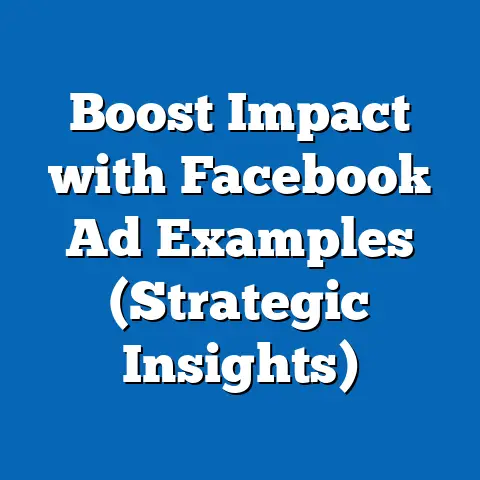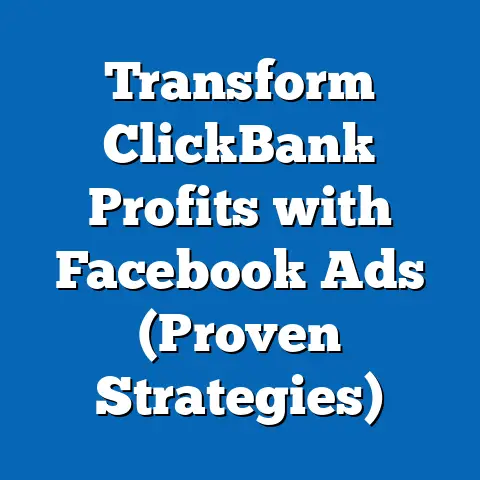Overcoming Facebook Ads Pitfalls (Essential Strategies Revealed)
Understanding the Landscape of Facebook Advertising
Facebook isn’t just a social network; it’s a digital advertising powerhouse. In today’s marketing landscape, ignoring Facebook’s advertising potential is akin to ignoring a massive segment of your target audience. With billions of active users, Facebook offers unparalleled reach and targeting capabilities.
Think about it: almost everyone you know is on Facebook, scrolling through their newsfeed daily. This constant engagement provides a unique opportunity to connect with potential customers at various stages of their buying journey. Whether you’re trying to build brand awareness, generate leads, or drive sales, Facebook Ads can be a powerful tool in your arsenal.
The key, however, is execution. A poorly executed Facebook ad campaign can be a black hole for your marketing budget. But when done right, the ROI can be phenomenal, far exceeding traditional advertising methods.
Common Pitfalls in Facebook Advertising
Over the years, I’ve noticed some recurring themes in why Facebook ad campaigns fail. Let’s break down the most common pitfalls:
Targeting Errors: Shooting in the Dark
One of the biggest mistakes I see is a lack of precise targeting. Many advertisers think a broad audience will yield more results, but this often leads to wasted ad spend. Imagine trying to sell vegan protein powder to a group of meat-lovers – you’re unlikely to get many conversions.
Facebook’s strength lies in its ability to target specific demographics, interests, behaviors, and even life events. Failing to leverage these granular targeting options is like throwing darts blindfolded.
Neglecting A/B Testing: Guesswork Over Data
Another common mistake is the absence of A/B testing. I’ve often encountered businesses that create one ad and assume it’s the best possible version. But how can you know without testing?
A/B testing involves creating multiple versions of an ad with slight variations – different headlines, images, call-to-actions – and running them simultaneously to see which performs best. Without this, you’re relying on guesswork, which is rarely a winning strategy.
Ignoring Analytics: Flying Blind
Ignoring these analytics is like driving a car without looking at the dashboard; you might reach your destination, but you’re more likely to crash along the way.
Poor Creative: Losing the Attention Game
In a world saturated with content, capturing and holding attention is paramount. Poorly designed visuals, irrelevant images, or unengaging ad copy can cause your ads to be quickly scrolled past.
I’ve seen ads with blurry images, walls of text, and unclear value propositions. These ads simply don’t stand a chance against the visually appealing, concise, and benefit-driven ads that dominate the newsfeed.
Essential Strategies to Overcome Pitfalls
Now, let’s get to the good stuff – the strategies you can implement to overcome these common pitfalls and achieve Facebook Ads success.
Strategic Targeting: Hitting the Bullseye
To avoid targeting errors, I always start with a deep dive into understanding my ideal customer. Here’s how I approach it:
- Create Detailed Buyer Personas: Don’t just think about demographics; consider their interests, pain points, and online behaviors. Are they eco-conscious millennials who enjoy outdoor activities? Or busy professionals seeking time-saving solutions? The more specific you are, the better.
- Leverage Facebook’s Targeting Options:
- Interest-Based Targeting: Target users based on their expressed interests and hobbies.
- Behavioral Targeting: Reach users based on their purchasing behaviors, travel habits, and other activities.
- Custom Audiences: Upload your existing customer lists to target them directly or create lookalike audiences (more on that later).
- Lookalike Audiences: Expand your reach by targeting users who share similar characteristics with your existing customers.
- Interest-Based Targeting: Target users based on their expressed interests and hobbies.
- Behavioral Targeting: Reach users based on their purchasing behaviors, travel habits, and other activities.
- Custom Audiences: Upload your existing customer lists to target them directly or create lookalike audiences (more on that later).
- Lookalike Audiences: Expand your reach by targeting users who share similar characteristics with your existing customers.
Example: Let’s say I’m advertising a new line of organic skincare products. Instead of broadly targeting “women,” I might target women aged 25-45 interested in organic beauty, sustainable living, and specific skincare concerns like anti-aging or acne.
A/B Testing for Success: Data-Driven Decisions
A/B testing is not just a nice-to-have; it’s a necessity. Here’s my structured approach:
- Identify What to Test: Don’t try to test everything at once. Focus on one or two key elements at a time:
- Headlines: Test different value propositions and emotional triggers.
- Images/Videos: Experiment with different visuals to see what resonates best.
- Call-to-Actions: Try different CTAs like “Shop Now,” “Learn More,” or “Get Started.”
- Ad Copy: Tweak your ad copy to highlight different benefits or address specific pain points.
- Create Variations: Create at least two variations of each element you want to test.
- Run Tests Simultaneously: Ensure your tests run at the same time to avoid external factors influencing the results.
- Analyze Results and Optimize: Monitor the performance of each variation closely. Once you have enough data (usually after a few days or a week), identify the winner and implement it in your main campaign.
- Headlines: Test different value propositions and emotional triggers.
- Images/Videos: Experiment with different visuals to see what resonates best.
- Call-to-Actions: Try different CTAs like “Shop Now,” “Learn More,” or “Get Started.”
- Ad Copy: Tweak your ad copy to highlight different benefits or address specific pain points.
Real-Life Example: I once ran an A/B test for a client selling online courses. We tested two headlines: “Learn Digital Marketing in 30 Days” vs. “Become a Digital Marketing Expert.” The second headline, which focused on the aspirational outcome, resulted in a 30% higher click-through rate.
Leveraging Data Analytics: Turning Insights into Action
Facebook Ads Manager is your best friend when it comes to data analytics. Here’s how to make the most of it:
- Understand Key Metrics:
- Click-Through Rate (CTR): Measures how often people who see your ad click on it. A high CTR indicates that your ad is relevant and engaging.
- Cost Per Click (CPC): The amount you pay each time someone clicks on your ad. A lower CPC means you’re getting more traffic for your budget.
- Conversion Rate: The percentage of people who click on your ad and then complete a desired action (e.g., make a purchase, fill out a form).
- Cost Per Acquisition (CPA): The amount you pay to acquire a new customer. This is a critical metric for measuring ROI.
- Set Up Conversion Tracking: Use Facebook Pixel to track user behavior on your website and measure conversions accurately.
- Analyze Performance Regularly: Don’t just set it and forget it. Check your analytics daily or at least a few times a week to identify trends and make adjustments.
- Click-Through Rate (CTR): Measures how often people who see your ad click on it. A high CTR indicates that your ad is relevant and engaging.
- Cost Per Click (CPC): The amount you pay each time someone clicks on your ad. A lower CPC means you’re getting more traffic for your budget.
- Conversion Rate: The percentage of people who click on your ad and then complete a desired action (e.g., make a purchase, fill out a form).
- Cost Per Acquisition (CPA): The amount you pay to acquire a new customer. This is a critical metric for measuring ROI.
Example: If I notice that my ad has a high CTR but a low conversion rate, it suggests that my ad is attracting the right audience, but something is preventing them from completing the desired action on my website. I might then focus on optimizing my landing page or simplifying the checkout process.
Crafting Compelling Creative: Grabbing Attention
To create ads that stand out, focus on these elements:
- High-Quality Visuals: Use crisp, clear images or videos that are relevant to your product or service.
- Concise and Benefit-Driven Ad Copy: Highlight the key benefits of your offer in a clear and concise way. Avoid jargon and focus on what the customer will gain.
- Strong Call-to-Action: Tell people exactly what you want them to do – “Shop Now,” “Sign Up Today,” “Get Your Free Trial.”
- Storytelling: Use storytelling to connect with your audience on an emotional level. Share customer testimonials, success stories, or behind-the-scenes glimpses into your brand.
Example: I worked with a local bakery to create a Facebook ad campaign. Instead of simply showcasing pictures of their pastries, we created a short video featuring a customer enjoying their morning coffee and croissant, talking about how it brightened their day. This storytelling approach resonated much more with the audience and drove a significant increase in foot traffic to the bakery.
Advanced Techniques for Sustained Success
Once you’ve mastered the basics, you can explore these advanced techniques to take your Facebook Ads to the next level:
Retargeting: Re-Engaging Potential Customers
Retargeting involves showing ads to people who have previously interacted with your website or Facebook page. This can be incredibly effective because these users are already familiar with your brand and are more likely to convert.
Example: If someone visits your product page but doesn’t make a purchase, you can retarget them with an ad featuring that specific product and a special discount.
Lookalike Audiences: Expanding Your Reach
Lookalike audiences allow you to reach new people who share similar characteristics with your existing customers. This is a great way to expand your reach and target potential customers who are likely to be interested in your products or services.
Example: If you have a customer list of high-value clients, you can create a lookalike audience based on that list and target similar users on Facebook.
Facebook Pixel: Tracking User Behavior
Facebook Pixel is a small piece of code that you install on your website to track user behavior. This data can be used to optimize your ad campaigns, measure conversions, and create custom audiences.
Example: By tracking which pages users visit on your website, you can create retargeting ads that are tailored to their specific interests.
Multi-Channel Integration: Amplifying Your Efforts
Don’t rely solely on Facebook Ads. Integrate your Facebook advertising efforts with other marketing channels like email marketing, content marketing, and SEO to create a cohesive and effective marketing strategy.
Example: If you generate leads through Facebook Ads, nurture them with a series of automated emails to guide them through the sales funnel.
Keeping Up with Facebook’s Evolving Policies
Facebook’s advertising policies are constantly evolving, so it’s crucial to stay updated to avoid ad disapproval. Familiarize yourself with the latest guidelines and ensure your ads comply with all requirements.
Example: Facebook has strict rules about advertising certain products and services, such as alcohol, gambling, and health supplements. Make sure you understand these rules before launching your campaign.
Conclusion
Facebook advertising can be a powerful tool for growth, but it’s essential to understand the common pitfalls and implement effective strategies to overcome them. By focusing on strategic targeting, A/B testing, data analytics, and compelling creative, you can create Facebook ad campaigns that deliver real results.
Don’t let the complexities of Facebook Ads intimidate you. Transform your Facebook Ads from a pitfall to a powerful tool for growth – start implementing these strategies today and watch your business soar. I’ve seen firsthand how these strategies can turn struggling campaigns into roaring successes, and I’m confident they can do the same for you. Now, go out there and conquer the Facebook Ads landscape!

